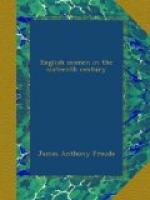Off the Start there was a fresh disaster. Everyone was in ill-humour. A quarrel broke out between the soldiers and seamen in Oquendo’s galleon. He was himself still absent. Some wretch or other flung a torch into the powder magazine and jumped overboard. The deck was blown off, and 200 men along with it.
Two such accidents following an unsuccessful engagement did not tend to reconcile the Spaniards to the Duke’s command. Pedro de Valdez was universally loved and honoured, and his desertion in the face of an enemy so inferior in numbers was regarded as scandalous poltroonery. Monday morning broke heavily. The wind was gone, but there was still a considerable swell. The English were hull down behind. The day was spent in repairing damages and nailing lead over the shot-holes. Recalde was moved to the front, to be out of harm’s way, and De Leyva took his post in the rear.
At sunset they were outside Portland. The English had come up within a league; but it was now dead calm, and they drifted apart in the tide. The Duke thought of nothing, but at midnight the Spanish officers stirred him out of his sleep to urge him to set his great galleasses to work; now was their chance. The dawn brought a chance still better, for it brought an east wind, and the Spaniards had now the weather-gage. Could they once close and grapple with the English ships, their superior numbers would then assure them a victory, and Howard, being to leeward and inshore, would have to pass through the middle of the Spanish line to recover his advantage. However, it was the same story. The Spaniards could not use an opportunity when they had one. New-modelled for superiority of sailing, the English ships had the same advantage over the galleons as the steam cruisers would have over the old three-deckers. While the breeze held they went where they pleased. The Spaniards were out-sailed, out-matched, crushed by guns of longer range than theirs. Their own shot flew high over the low English hulls, while every ball found its way through their own towering sides. This time the San Martin was in the thick of it. Her double timbers were ripped and torn; the holy standard was cut in two; the water poured through the shot-holes. The men lost their nerve. In such ships as had no gentlemen on board notable signs were observed of flinching.




